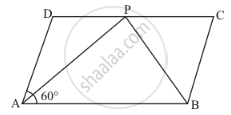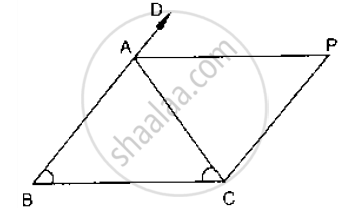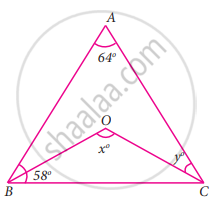Advertisements
Advertisements
Question
Prove that the quadrilateral formed by the bisectors of the angles of a parallelogram is a rectangle.
Solution

Given: Let ABCD be a parallelogram and AP, BR, CR, be are the bisectors of ∠A, ∠B, ∠C and ∠D, respectively.
To prove: Quadrilateral PQRS is a rectangle.
Proof: Since, ABCD is a parallelogram, then DC || AB and DA is a transversal.
∠A + ∠D = 180° ...[Sum of cointerior angles of a parallelogram is 180°]
⇒ `1/2` ∠A + `1/2` ∠D = 90° ...[Dividing both sides by 2]
∠PAD + ∠PDA = 90°
∠APD = 90° ...[Since, sum of all angles of a triangle is 180°]
∴ ∠SPQ = 90° ...[Vertically opposite angles]
∠PQR = 90°
∠QRS = 90°
And ∠PSR = 90°
Thus, PQRS is a quadrilateral whose each angle is 90°.
Hence, PQRS is a rectangle.
APPEARS IN
RELATED QUESTIONS
In Fig., below, ABCD is a parallelogram in which ∠A = 60°. If the bisectors of ∠A and ∠B meet at P, prove that AD = DP, PC = BC and DC = 2AD.

P and Q are the points of trisection of the diagonal BD of a parallelogram AB Prove that CQ is parallel to AP. Prove also that AC bisects PQ.
In Fig. below, AB = AC and CP || BA and AP is the bisector of exterior ∠CAD of ΔABC.
Prove that (i) ∠PAC = ∠BCA (ii) ABCP is a parallelogram

In a parallelogram ABCD, the bisector of ∠A also bisects BC at X. Find AB : AD.
We get a rhombus by joining the mid-points of the sides of a
The figure formed by joining the mid-points of the adjacent sides of a rhombus is a
ABCD is a parallelogram in which diagonal AC bisects ∠BAD. If ∠BAC = 35°, then ∠ABC =
P is the mid-point of side BC of a parallelogram ABCD such that ∠BAP = ∠DAP. If AD = 10 cm, then CD =
In the given figure, ∠A = 64°, ∠ABC = 58°. If BO and CO are the bisectors of ∠ABC and ∠ACB respectively of ΔABC, find x° and y°
ABCD is a square, diagonals AC and BD meet at O. The number of pairs of congruent triangles with vertex O are
